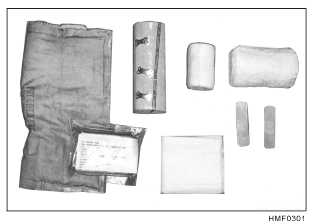to slip after it is in place, the dressing is no longer
sterile.
Should an emergency arise when a sterile dressing
is not available, the cleanest cloth at hand may be
used—a freshly laundered handkerchief, towel, or
shirt, for instance. Unfold these materials carefully so
that you do not touch the part that goes next to the skin.
Always be ready to improvise when necessary, but
never put materials directly in contact with wounds if
those materials are likely to stick to the wound, leave
lint, or be difficult to remove.
DEFINITION OF A BANDAGE
Standard bandages are made of gauze or muslin
and are used over a sterile dressing to secure the
dressing in place, to close off its edge from dirt and
germs, and to create pressure on the wound and control
bleeding. A bandage can also support an injured part or
secure a splint. The most common types of bandages
are the roller and triangular bandages.
Roller Bandage
The roller bandage, shown in figure 3–2, consists
of a long strip of material (usually gauze, muslin, or
elastic) that is wound into a cylindrical shape. Roller
bandages come in various widths and lengths. Most of
the roller bandages in the first aid kits have been
sterilized, so pieces may be cut off and used as
compresses in direct contact with wounds. If you use a
piece of roller bandage in this manner, you must be
careful not to touch it with your hands or with any other
unsterile object.
GENERAL APPLICATION.—In applying a
roller bandage, hold the roll in the right hand so that the
loose end is on the bottom; the outside surface of the
loose or initial end is next applied to and held on the
body part by the left hand. The roll is then passed
around the body part by the right hand, which controls
the tension and application of the bandage. Two or
three of the initial turns of a roller bandage should
overlie each other to properly secure the bandage (see
figure 3–3).
In applying the turns of the bandage, it is often
necessary to transfer the roll from one hand to the
3-3
AMBULANCE EMERGENCY BAG CONTENTS
Regular drip IV
tubing
Ambu bag
Syrup of Ipecac
Mini drip IV tubing
Trach adaptor
Ace® wrap
IV extension tubing
Suction tubing
Klings®
19-gauge butterflies
Straight &
Y-connector
Arm slings
18-gauge Medicut®
Toomey syringe
Safety pins
16-gauge Medicut®
10cc syringe
Tongue blades
Tourniquet
20-gauge needles
Tape
Adult oxygen mask
Alcohol swabs
Stethoscope
Nasal cannula
Examination
gloves
4 x 4’s
Oxygen tubing
Sodium Chloride
ampules
Lubricant
Airways (various
sizes)
Ammonia ampules
Grease pencil
Table 3-2.—Ambulance Emergency Bag Contents
UNIT ONE BAG CONTENTS
One roll wire fabric, 5" x 36"
One tourniquet
Two bottles of aspirin, 324 mg,
100s
One pair scissors, bandage
Three packages of morphine
inj., 1/4 g, 5s
Six packages of plastic strip
bandages, 6s
One bottle tetracaine
hydrochloride ophthalmic sol.
Three bottles
povidone-iodine solution,
1/2 fl oz
One airway, plastic, adult/
child
One thermometer, oral
Two packages atropine inj.,
12s
One card of safety pins,
medium, 12s
Two muslin triangular
bandages
Two books field medical
cards
Two medium battle dressings,
7 1/4" x 8"
One surgical instrument
set, minor surgery
Eight small battle dressings
4" x 7"
One pencil, black lead,
mechanical
One roll adhesive tape,
3 in x 5 yds
Two packages gauze,
rolled, 3 in x 5 yds
Table 3–3.—Unit One Bag Contents
Figure 3–1.—Commonly used styles of dressings.

